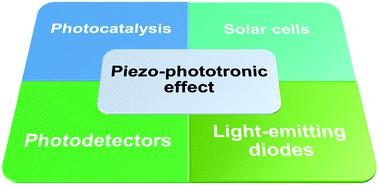当前位置:
X-MOL 学术
›
Chem. Soc. Rev.
›
论文详情
Our official English website, www.x-mol.net, welcomes your
feedback! (Note: you will need to create a separate account there.)
Piezo-phototronic effect on photocatalysis, solar cells, photodetectors and light-emitting diodes
Chemical Society Reviews ( IF 40.4 ) Pub Date : 2021-11-25 , DOI: 10.1039/d1cs00506e Baoying Dai 1 , Gill M Biesold 1 , Meng Zhang 1 , Haiyang Zou 1 , Yong Ding 1 , Zhong Lin Wang 1 , Zhiqun Lin 1
Chemical Society Reviews ( IF 40.4 ) Pub Date : 2021-11-25 , DOI: 10.1039/d1cs00506e Baoying Dai 1 , Gill M Biesold 1 , Meng Zhang 1 , Haiyang Zou 1 , Yong Ding 1 , Zhong Lin Wang 1 , Zhiqun Lin 1
Affiliation

|
The piezo-phototronic effect (a coupling effect of piezoelectric, photoexcitation and semiconducting properties, coined in 2010) has been demonstrated to be an ingenious and robust strategy to manipulate optoelectronic processes by tuning the energy band structure and photoinduced carrier behavior. The piezo-phototronic effect exhibits great potential in improving the quantum yield efficiencies of optoelectronic materials and devices and thus could help increase the energy conversion efficiency, thus alleviating the energy shortage crisis. In this review, the fundamental principles and challenges of representative optoelectronic materials and devices are presented, including photocatalysts (converting solar energy into chemical energy), solar cells (generating electricity directly under light illumination), photodetectors (converting light into electrical signals) and light-emitting diodes (LEDs, converting electric current into emitted light signals). Importantly, the mechanisms of how the piezo-phototronic effect controls the optoelectronic processes and the recent progress and applications in the above-mentioned materials and devices are highlighted and summarized. Only photocatalysts, solar cells, photodetectors, and LEDs that display piezo-phototronic behavior are reviewed. Material and structural design, property characterization, theoretical simulation calculations, and mechanism analysis are then examined as strategies to further enhance the quantum yield efficiency of optoelectronic devices via the piezo-phototronic effect. This comprehensive overview will guide future fundamental and applied studies that capitalize on the piezo-phototronic effect for energy conversion and storage.
中文翻译:

压电光电效应对光催化、太阳能电池、光电探测器和发光二极管的影响
压电光电子效应(压电、光激发和半导体特性的耦合效应,于 2010 年创造)已被证明是通过调整能带结构和光致载流子行为来操纵光电过程的巧妙而稳健的策略。压电光电子效应在提高光电材料和器件的量子产率方面具有巨大潜力,有助于提高能量转换效率,从而缓解能源短缺危机。在这篇综述中,介绍了代表性光电材料和器件的基本原理和挑战,包括光催化剂(将太阳能转化为化学能)、太阳能电池(直接在光照下发电)、光电探测器(将光转换为电信号)和发光二极管(LED,将电流转换为发射的光信号)。重要的是,强调并总结了压电光电子效应如何控制光电过程的机制以及上述材料和器件的最新进展和应用。仅审查了显示压电光电行为的光催化剂、太阳能电池、光电探测器和 LED。然后将材料和结构设计、特性表征、理论模拟计算和机理分析作为进一步提高光电器件量子产率效率的策略进行检查 强调并总结了压电光电子效应如何控制光电过程的机制以及上述材料和器件的最新进展和应用。仅审查了显示压电光电行为的光催化剂、太阳能电池、光电探测器和 LED。然后将材料和结构设计、特性表征、理论模拟计算和机理分析作为进一步提高光电器件量子产率效率的策略进行检查 强调并总结了压电光电子效应如何控制光电过程的机制以及上述材料和器件的最新进展和应用。仅审查了显示压电光电行为的光催化剂、太阳能电池、光电探测器和 LED。然后将材料和结构设计、特性表征、理论模拟计算和机理分析作为进一步提高光电器件量子产率效率的策略进行检查通过压电光电效应。这一全面的概述将指导未来利用压电光电效应进行能量转换和存储的基础和应用研究。
更新日期:2021-11-25
中文翻译:

压电光电效应对光催化、太阳能电池、光电探测器和发光二极管的影响
压电光电子效应(压电、光激发和半导体特性的耦合效应,于 2010 年创造)已被证明是通过调整能带结构和光致载流子行为来操纵光电过程的巧妙而稳健的策略。压电光电子效应在提高光电材料和器件的量子产率方面具有巨大潜力,有助于提高能量转换效率,从而缓解能源短缺危机。在这篇综述中,介绍了代表性光电材料和器件的基本原理和挑战,包括光催化剂(将太阳能转化为化学能)、太阳能电池(直接在光照下发电)、光电探测器(将光转换为电信号)和发光二极管(LED,将电流转换为发射的光信号)。重要的是,强调并总结了压电光电子效应如何控制光电过程的机制以及上述材料和器件的最新进展和应用。仅审查了显示压电光电行为的光催化剂、太阳能电池、光电探测器和 LED。然后将材料和结构设计、特性表征、理论模拟计算和机理分析作为进一步提高光电器件量子产率效率的策略进行检查 强调并总结了压电光电子效应如何控制光电过程的机制以及上述材料和器件的最新进展和应用。仅审查了显示压电光电行为的光催化剂、太阳能电池、光电探测器和 LED。然后将材料和结构设计、特性表征、理论模拟计算和机理分析作为进一步提高光电器件量子产率效率的策略进行检查 强调并总结了压电光电子效应如何控制光电过程的机制以及上述材料和器件的最新进展和应用。仅审查了显示压电光电行为的光催化剂、太阳能电池、光电探测器和 LED。然后将材料和结构设计、特性表征、理论模拟计算和机理分析作为进一步提高光电器件量子产率效率的策略进行检查通过压电光电效应。这一全面的概述将指导未来利用压电光电效应进行能量转换和存储的基础和应用研究。


















































 京公网安备 11010802027423号
京公网安备 11010802027423号